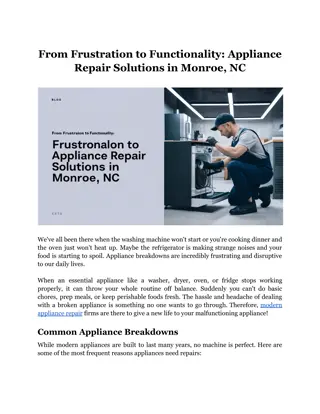Appliance Industry Outlook: Trends and Challenges
The appliance industry in the US experienced fluctuations in sales and shipments in recent years. While there are positive signs of recovery, challenges persist, such as the slow adoption of smart appliances by consumers. Major players like Samsung and Whirlpool are competing for market share amidst changing consumer preferences. The sector is cautiously optimistic about potential growth and retail success.
Uploaded on Sep 26, 2024 | 2 Views
Download Presentation

Please find below an Image/Link to download the presentation.
The content on the website is provided AS IS for your information and personal use only. It may not be sold, licensed, or shared on other websites without obtaining consent from the author.If you encounter any issues during the download, it is possible that the publisher has removed the file from their server.
You are allowed to download the files provided on this website for personal or commercial use, subject to the condition that they are used lawfully. All files are the property of their respective owners.
The content on the website is provided AS IS for your information and personal use only. It may not be sold, licensed, or shared on other websites without obtaining consent from the author.
E N D
Presentation Transcript
Better Days on the Horizon for Appliances Unadjusted 2017 sales at home appliance stores were $15.535 billion, a 9.7% decrease from 2016 s $17.199 billion. Although the overall economy is strong, US appliance manufacturing is still only approximately half of its total prior to the recession. Unadjusted sales at home appliance stores during the first half of 2018 were better, decreasing 2.1%, from $7.757 billion for the first half of 2017 to $7.596 billion. Appliance industry analysts view August 2018 s 9.2% MOM increase in housing starts, as a potential sign appliance manufacturing could still end the year with a 4% increase, which would be a positive trend for retail appliance sales.
Some Positive Summer Shipment Totals Are Encouraging Total 2017 major appliances shipments decreased 12% to 4.923 million units from 2016 s 5.595 million units. The four worst categories were, dehumidifiers, -44.2%; room air conditioners, -53.9%; home comfort, -52.9%; and freezers, -37.7%. Gas cooking, at +7.0%, had the largest increase of 2017 shipments, with gas ranges, +8.1%; wall ovens, +4.4%; and surface cooking units, +9.5%, within the gas- cooking category. Dryers, +5.5%, and refrigerators, +4.1%, were the others with increases. Total wholesale shipments increased 2.8% for July 2018, but decreased 1.2% for August 2018. The 6 primary categories washers, dryers, dishwashers, refrigerators, freezers and ranges/ovens decreased 2.0% for July and another 5.3% for August.
Consumers Yet To Embrace Smart Appliances As presented in Media Group Online s October 2018 Special Report, The Smart Life, most consumers experience with smart technology is generally limited to their smartphone and a smart TV, of which 38% of Internet users owned as of January 2018. In the same January 2018 survey from Fluent, just 7% of Internet users said they owned a smart kitchen appliance, which suggests there is an untapped market for the increasing number of smart appliances designed for convenience and other benefits. For example, consumers who own any of Whirlpool s smart appliances can use Google Assistant to start the dishwasher and Whirlpool refrigerators with an LCD touchscreen allow Amazon Prime members to order food and household items directly.
Manufacturing and Retail Success Concentrated at the Top With 19.5% of all refrigerators, washing machines and microwaves sold in the US during 2017, Samsung Electronics was the #1 appliance manufacturer for the second consecutive year, with LG Electronics advancing to #2 with a 15.7% share. Whirlpool s 15.4% market share forced it from #2 for 2016 to #3 for 2017, followed by General Electric and Kenmore, which lost more market share, from just more than 10% during 2016 to approximately 8% for 2017. To compete with The Home Depot and Lowe s, which account for almost 50% of all major appliance retail sales, many smaller retailers have joined buying groups, such as Appliance Dealers Cooperative (ADC) and its almost 200 dealers in 10 states.
Consumers Know What They Like The indices for all major household appliance brands listed in The American Customer Satisfaction Index decreased from 2016 to 2017, with the average for all appliances decreasing from 82 to 80. LG still led with an index of 83. In J.D. Power s 2018 Kitchen Appliance Satisfaction StudySMand 2018 Laundry Appliance Satisfaction StudySM, LG led in 4 of the 11 categories: side-by-side refrigerators, top-mount freezer refrigerators, freestanding ranges and top-load washers. Bosch led in 3 categories: cooktops, wall ovens and over-the-range microwaves, while Kenmore led in French-door refrigerators and Kenmore Elite, clothes dryers. Maytag led the dishwashers category and Samsung, front-load washers.
Appliances Markets Shiny Future During September 2018, Amazon announced numerous new Alexa-based products, which include its first Amazon-brand appliance, a 700W-microwave with quick-cook voice presets and a Dash Replenishment feature to reorder popcorn. New smart technologies for appliances are being rapidly developed, such as RF (radio frequency) technology recently introduced in Europe that uses different frequencies to cook different parts (protein, fat, etc.) of a food item. The Home Improvement Research Institute (HIRI) has forecast the consumer market for major household appliances will total $23.5 billion for 2018, and then increase to $27.0 billion by 2022.
Advertising Strategies Often, when a retailer is confronted with a potential problem, it s best to use it as an advertising advantage. Help local appliance dealers promote a Beat the Tariffs campaign, showing how much consumers will save buying an appliance before tariffs are applied. To promote the value of smart appliances, suggest retailers host one or more seminars/demonstrations about their convenience and other benefits, which could be held in the common areas of shopping malls. Appliance dealers could offer one of the new Amazon Echo products as a free incentive with a qualifying purchase. The new Wi-Fi Smart Plug adds voice control to appliances and other devices via an electrical outlet.
New Media Strategies Suggest appliance dealer recruit a loyal customer to serve as a smart appliance influencer, posting content on social media and/or the dealer s Website about the benefits of having one or more smart appliance and the features he or she likes best. Dealers can search for existing content of laundry tips, how to use a microwave, proper cleaning of surface cooking units, etc. and curate those sources on their Websites and/or use them as social media posts. To make the delivery and installation process as easy as possible for customers, dealers should have their delivery teams use text messaging to introduce themselves (and with photos) and indicate their arrival time when they are within a half-hour of the home.























